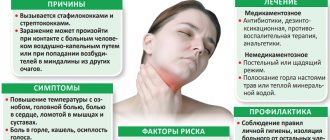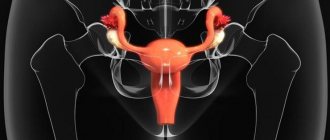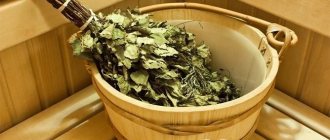In the old days they said: “I went to the bathhouse and all my ailments went away...” Today, doctors are skeptical about bathhouses and water procedures in general. Most often, bath procedures are strictly prohibited, while there are also those who confidently declare: “I always feel better after a bath.” The most pressing question arises when a runny nose begins. Is it really possible to go to a bathhouse or sauna with a runny nose? Will such procedures be useful?
Bath “therapies” have always been considered a good preventive measure for colds. Even in ancient times, the effect of such treatment was noticeable and bath procedures, together with herbal decoctions, were widely popular.
What is the effect of visiting a bathhouse on a runny nose?
The bathhouse has been used for a long time for the treatment and prevention of colds, runny noses and coughs. This tool has many advantages:
helps speed up metabolism; allows you to remove toxins and waste from the body with sweat; improves blood flow; strengthens the immune system; cleanses the nasopharynx by thinning mucus and improving its removal; eases cough by thinning mucus in the respiratory tract, which improves expectoration; stimulates the production of interferon, effectively fighting viral infection.
To produce interferon, the body needs to independently increase body temperature, which usually occurs with ARVI. If, when the first symptoms of a runny nose appear, you visit the bathhouse in a timely manner, the production of the substance is activated under the influence of an artificial increase in body temperature from an external source. The body is exposed to less stress and begins to fight viruses more effectively.
In a bath, a person’s production of leukocytes increases by 20%, which helps block the spread of infection into the blood.
The bath has a complex effect on the body as a whole, therefore, together with the treatment of a runny nose, it has a healing effect on the skin, cardiovascular system, and internal organs. High temperatures cause blood vessels to dilate, blood to flow faster and saturate tissues and organs with useful substances, which increases the productivity of their work.
Thanks to increased sweating in the bath, the body undergoes detoxification and deslagging. Due to the breakdown of fat, weight is reduced and the kidneys are unloaded.
However, it is important to remember that intensive removal of mucus from the nose can cause infection of others, and in humid air, bacteria multiply faster. Therefore, it is not recommended to be in a steam room with healthy people.
What to do - is it possible to wash your face with conjunctivitis?
Of course, you can wash your face, especially if your form of the disease is associated with constant discharge from the eyes so that they do not have time to dry out. Tap water is not recommended as it may contain bacteria. It is worth remembering the general hygiene rules mentioned earlier and knowing how to properly wash your eyes. To do this, you need to drop a few drops of saline solution into the inner corner of the eye or into the neatly pulled back lower eyelid. Rinse your eyes from the outer corner of the eye towards the nose.
In what cases should you not go to the bathhouse?
Like any medicine, the bath has contraindications.
High body temperature, at which the danger lies in possible swelling of the nasal mucosa and acceleration of the process of bacterial growth. And with fever, the load on the blood vessels and heart increases. ARVI is at the initial stage, since at this time the body is intensively fighting the virus, and a bath can aggravate the disease and cause unwanted complications. Thick mucus during a runny nose with a yellowish and greenish tint, which is the cause of bacterial infection, which is aggravated by exposure to elevated temperatures and humid air (more than 70%). Age up to three years, at which time the body is susceptible to various types of infections, and high ambient temperatures can cause a number of serious complications. Acute infections of a viral nature, for example, chickenpox, herpes. Headache, in which high temperatures provoke vasodilation, which can cause a stroke. Heart disease. Doctor's prescriptions. Some chronic diseases.
After an exacerbation of the chronic form of the disease, a consultation with a doctor is recommended. Otherwise, you can cause a relapse with more serious consequences.
Acute conjunctivitis
This form of inflammation is also called epidemic conjunctivitis. It occurs as a result of the Koch-Wicks bacillus entering the body. This disease is usually diagnosed in children. People become infected with it in kindergartens or schools, and a large number of people get sick at once. The infection flares up in the spring and summer. Bacteria are transmitted from one person to another through conversation or contact. You can become infected through household items, dishes, and food. It is clear that with such conjunctivitis you cannot go to the bathhouse or swimming pool. The patient is contagious. A school or kindergarten may be closed for quarantine.
The pathology develops very quickly. The incubation period, which in other forms of inflammation of the eye mucosa can last up to 10 days, in acute conjunctivitis lasts no more than 1-2 days. Both eyes are affected. The disease begins to manifest itself with redness of the eyelids and conjunctiva, and swelling develops in the lower eyelid area. It takes the form of a roller. Purulent or mucopurulent discharge, thin brown films are observed in the eyes, which can be removed without damaging the mucous membrane. Numerous hemorrhages are visible to the naked eye in the connective membrane. They appear as dots. The patient suffers from severe lacrimation.
How to steam properly?
Rules for using a bath to treat a runny nose:
bath preparation. The steam room should be well heated, the stones should be heated. You can create healing hot steam by wetting the stones with water and oils or herbs. The procedure time should not exceed 15 minutes with breaks every 3 minutes. The release of sweat signals the beginning of the positive effects of heat. You can enhance the process with a herbal broom. With the help of massage, blood flow increases, which promotes rapid recovery. With adequate preparation, after the steam room you should take a cold shower or jump into the pool. The contrast effect activates the body's systems to work positively. You can’t get too cold, so after cold water you need to rub yourself thoroughly and wrap yourself in a towel. In the steam room you need to wear a felt or linen hat, which will protect the blood vessels of the head from high temperatures. Bath procedures should be combined with drinking herbal teas. Add essential oils to the stones, which has a beneficial effect on the mucous membrane when inhaling, calms and tones the body.
Bath treatments for runny nose
Bath decoctions
A common recipe is dry mustard diluted in water. 1 teaspoon per ladle of boiling water is enough. The composition should be poured in small doses onto the stones. If this method is problematic to implement, you can moisten a cotton pad in the solution and apply it to the nostrils one by one.
An effective remedy is the herbal infusion of wild rosemary: 100 g of herb is ground and infused for three weeks in a tablespoon of olive oil. The strained infusion is diluted with 3 liters of water. The liquid is poured in small portions onto the stones. You can drip the product into your nose.
Essential oils of eucalyptus, pine, mint, fir, geranium, rosemary, individually and in mixtures, have an effective effect on the body during a runny nose.
You can use tinctures of chamomile and thyme, prepared by boiling 100 g of herbs in 250 ml of water. Elecampane is endowed with healing properties for a runny nose. Preparation recipe: add 10 g of crushed root to a glass of boiling water, then the liquid is infused in a water bath for 30 minutes. Before use, dilution in 2 liters of water is required. It should be poured onto the stones in doses.
A mixture of 3 g of licorice, elecampane and marshmallow roots, filled with two glasses of cold water, will help cure a runny nose and cough. The infusion is prepared for 8 hours, filtered and diluted in 2 liters of water. The liquid is gradually poured onto the hot stones.
Contrast shower or pool
Contrast procedures harden the body and train the immune system. But for a runny nose, it should be used only with prior preparation. In its absence, it is better to refuse the procedure.
Medicinal teas
Healing teas, juices and drinks work well in the baths.
Drinking infusion of buckwheat flowers: 40 g per 1 liter of boiling water. Violet tea: 10 g per 250 ml of boiling water. Infusion of a mixture of herbs and berries: 5 g each of fennel fruits, linden flowers, leaves of coltsfoot, meadowsweet and 10 g of leaves raspberries are poured with a liter of boiling water. Before use, leave for 15 minutes. Tea from black poplar buds: 10 g of crushed fruits per 250 ml of boiling water. Drink in small portions after 15 minutes. Radish juice helps well in the initial stages of a runny nose. They drink it in a spoon three times a day. The honeycomb lids are chewed directly in the steam room.
Can a child go to the steam room with a runny nose?
Before going to the bathhouse with a child with a runny nose, you need to consult a pediatrician and weigh the pros and cons. For children under three years of age, the bathhouse is completely contraindicated. In the first years of life, babies have a completely different thermoregulation system, sweat glands are not yet developed, and mucous membranes function differently. Therefore, the consequences of using a bath as a remedy for a runny nose are fraught with unpredictable consequences. Doctors recommend taking only healthy children to the bathhouse.
But everything is individual. For some, heating in this way can cause mucus to drain into the bronchi, which can cause pneumonia. For others, the process will go right, and the runny nose will go away without consequences. Therefore, in older age, the procedure is possible only after consultation with a pediatrician and subject to the following rules:
adhere to contraindications; do not steam for too long; do not use excessively high temperatures; ensure warmth and rest after the procedure.
It is important to remember that the child’s body is susceptible to the emergence and spread of various types of infections. Therefore, even simple rhinitis after a bath can cause complications.
The bathhouse is a universal means of healing that has a beneficial effect on the body as a whole. Since ancient times, bath procedures were considered a real panacea against colds.
The therapeutic effect of the bath is due to the destructive effect of high temperature on pathogenic microorganisms. Hot steam helps open skin pores, remove dirt and toxins from them, and cleanse the skin of microparticles of dying cells. In addition, such thermal procedures perfectly stimulate blood circulation and increase tone. The hot air in the steam room causes many physiological processes to occur at a higher speed.
If you have a cold accompanied by a runny nose, you can and even need to go to the bathhouse. However, like any treatment, bath therapy requires a competent approach and adherence to certain rules for visiting the bath during illness.
Treatment of conjunctivitis
This disease can be treated by a general practitioner, ophthalmologist or allergist. They have no side effects and act quickly, immediately after instillation. Under no circumstances should bandages be applied, so as not to create conditions favorable for the proliferation of microbes.
When treating conjunctivitis, it is important to follow good hygiene. Therefore, doctors advise against visiting places such as bathhouses, swimming pools, and saunas. It is better to limit your social circle to a minimum so as not to cause an even greater spread of infection. Some forms of conjunctivitis, for example, adenoviral, are treated within a week or two, but for several days after all symptoms disappear a person can be contagious. When using droppers and ointment sticks, you need to boil them every day to kill germs. The same applies to towels, bed linen, and dishes.
Conjunctivitis is not a rare pathology, but it is also difficult to call it the most dangerous. If treatment is prescribed in a timely manner, the disease quickly recedes. Otherwise there may be complications. The most severe of them are clouding of the cornea and decreased visual acuity. If you follow all the doctor's instructions, this will not happen.
The benefits of a bath
Everyone knows that a bath is not only a pleasant pastime, but also an excellent means of preventing and treating various colds.
The benefits of bath therapy for a runny nose include:
Inhalations
Also read:
At the initial stage of development of the disease, steaming in a bathhouse, especially with the use of essential oils, is a kind of deep inhalation. This inhalation procedure helps to thin the viscous mucous secretion in the nasal cavity, improve its discharge, and normalize nasal breathing. For therapeutic measures aimed at eliminating a runny nose in a bathhouse, you can use mint, pine needle, and chamomile oils. Such inhalation has a huge advantage over the procedure performed at home, since the effect is not only on the nasal cavity, but also on the entire body as a whole.
Cleaning
In addition, the bath activates sweating, which removes waste and toxins that clog the body. Hot air also increases the production of interferon, which is an antiviral protein.
Massage with a bath broom improves blood circulation, which increases the level of protection of the immune system and also has a beneficial effect on the joints. If you have a cold accompanied by body aches, a bathhouse will be the best way to relieve this unpleasant symptom.
Strengthening immunity
During the process of steaming in a bathhouse, a person’s production of leukocytes, which block the development of various viruses, infections and bacteria, is accelerated by 20%. It follows from this that taking a steam bath when you have a runny nose is not only possible, but also very useful. However, like any therapeutic method, bath procedures have their own contraindications, which should be known before starting bath treatment.
Possible harm
Bath procedures undoubtedly bring great benefits to the entire body. But in some cases, going to the bathhouse with a runny nose is not recommended. You cannot go to the steam room if:
Exacerbation
The disease is in the acute stage. In the case when pathogenic microorganisms have seriously established themselves in the body, an increase in air temperature will only create favorable conditions for their active reproduction. This can trigger the progression of the disease, even to the occurrence of complications in the form of pneumonia, asthma or bronchitis.
Temperature
It is strictly forbidden to perform bath procedures at a body temperature exceeding 37 ̊ C. Any, even slight increase in temperature increases the load on the heart, and in combination with the thermal effects of the steam room, you can easily provoke a heart attack. It is not recommended to go to the bathhouse during acute rhinitis. Hot air can cause swelling of the nasal passages.
Headache
If you experience headaches as a result of a cold, visiting a steam room often causes dizziness and even sudden loss of consciousness.
Up to 3 years
As for bath therapy for a child with a runny nose, children should not go to the bath until the disease completely subsides. Children under 3 years of age are strictly prohibited from visiting the bathhouse.
Herpes
In case of exacerbation of herpes infection. High air humidity creates favorable conditions for the proliferation of the herpes virus, so if you have signs of the disease, it is not advisable to go to the bathhouse.
So, bath procedures will bring maximum benefit only at the initial stage of development of the disease or at the final stages. Otherwise, you can provoke a deterioration in the condition and aggravate the course of the disease. In any case, in order to avoid undesirable consequences, you should first consult with your doctor.
Causes of conjunctivitis
Conjunctivitis is a general name for a variety of eye diseases with one common symptom - inflammation of the connective membrane. Depending on the causes of the disease, conjunctivitis can be accompanied by a variety of symptoms. Factors that provoke inflammation in the mucous membrane of the eye can be divided into 2 groups:
1. Infection. Conjunctivitis can be a consequence of the ingestion of pathogenic and conditionally pathogenic bacteria (streptococci, staphylococci, Pseudomonas aeruginosa, gonococci), chlamydia, viruses (adenovirus, herpes), pathogenic fungi (aspergillus, spirotrichella). 2. Allergens. Allergic forms of conjunctivitis occur with poor care of contact lenses, in spring and summer during the flowering period of plants, and also as a reaction to certain medications. Other irritants can also trigger eye allergies: cosmetics, ultraviolet rays, pet hair, household chemicals, etc.
In addition to these reasons, there are other factors that, under unfavorable conditions for the body, can “trigger” the onset of the inflammatory process. Thus, conjunctivitis can occur against the background of keratoconjunctivitis, blepharitis and other ophthalmic pathologies. Overwork, a stressful situation, lack of sleep, hypothermia weaken the immune system, which is why viruses and bacteria can become more active and lead to inflammation.
The risk group includes people who have been diagnosed with one of the following diseases: farsightedness, myopia, astigmatism, dry eye syndrome, eyelid abnormalities, seborrhea, demodicosis, vitamin deficiency, helminthic infestations, anemia, diabetes mellitus, bronchial asthma, allergic rhinitis, digestive disorders, pathologies of the nose and nasolacrimal ducts.
Conjunctivitis is usually transmitted by airborne droplets or household contact. All of the above reasons lead to the development of the disease if the pathogenic microorganism appears directly on the conjunctiva. It is usually brought into the eyes with hands.
How to steam properly
To achieve the maximum therapeutic effect from the bath, you should follow some rules:
Before carrying out the procedure, the steam room should be thoroughly warmed up; To produce steam, the hot stones of the stove must be watered; You need to stay in the steam room for no more than 15 minutes. It is recommended to enter 2-3 times during one bath session. The effect will begin when sweating appears, which can be enhanced by massage with a bath broom; For colds accompanied by a runny nose, steam stones can be generously irrigated with chamomile, mint or eucalyptus esters. Thus, the therapeutic effect on the body is enhanced significantly; To avoid overheating of the head, you can wear a special felt hat; To restore health after an illness, it is advisable to combine a bath procedure with decoctions based on medicinal herbs. For this purpose, you can use herbs that have tonic and restorative properties.
A properly carried out bathing process will allow you to get rid of not only the unpleasant symptoms of a cold in a short time, but also the accumulated toxins, and will also help balance your state of mind, since everything in the human body is interconnected.
In the old days they said: “I went to the bathhouse and all my ailments went away...” Today, doctors are skeptical about bathhouses and water procedures in general. Most often, bath procedures are strictly prohibited, while there are also those who confidently declare: “I always feel better after a bath.” The most pressing question arises when a runny nose begins. Is it really possible to go to a bathhouse or sauna with a runny nose? Will such procedures be useful?
Bath “therapies” have always been considered a good preventive measure for colds. Even in ancient times, the effect of such treatment was noticeable and bath procedures, together with herbal decoctions, were widely popular.
Therapeutic procedure in the sauna
As soon as we notice the first signs of the disease, we immediately rush to say goodbye to it by vigorously warming it up. It is much easier to do this in a bathhouse. To increase sweating, therapeutic rubbing is used. For this purpose, special “sweat accelerators” are used. They usually contain salt and honey.
In order to obtain a rub, salt and honey are mixed in equal quantities and applied to well-warmed skin. If you are just starting to have a cough and runny nose, this procedure will be effective and will immediately eliminate the unpleasant symptoms of a cold. A bath for a runny nose is the best treatment.
Inhalations
To make it easier to breathe, you need to know how to properly supply aromatic steam. There are a huge number of recipes for its preparation. The main ingredients are:
- mint;
- needles;
- eucalyptus;
- thyme;
- chamomile.
A steam room in which the air is filled with the aromas of medicinal herbs is the best inhalation. Some dare to say that it gives positive and immediate results, unlike procedures that take place in the hospital. This inhalation option helps to breathe not only through the nose, but throughout the body. As a result of all this, we can safely say that a bath and a runny nose are compatible concepts. Having a comprehensive effect on the whole body, it helps eliminate a runny nose several times faster.
How to cure a runny nose in a bath using contrast procedures? It should be noted that they must be carried out observing all the rules of caution. If everything is done as expected, in the near future you will be able to forget about your stuffy nose and breathe deeply again. Those who have an untrained body should not run straight into a hot shower from a hot room. This will definitely not strengthen your immune system; moreover, you can get sick.
We have already found out whether it is possible to go to the bathhouse with a runny nose. What other treatments are used in bath conditions? You should not steam for too long, you need to take breaks. During warming up, the body needs a lot of fluid. It is needed to thoroughly cleanse the body and also support it.
Teas and herbal infusions will help get rid of a runny nose: thyme, linden, mint, chamomile, elderberry, lemon balm. Various anti-cold additives are optionally added to the finished tea: lemon, raspberries and honey.
If you come to the steam room to treat a runny nose, then you should try another procedure - steam with a broom. What's a bathhouse without a broom? This is more of a tradition than a rule. How is this procedure useful? It is able to activate sweating and enhance blood circulation in the capillaries. After a massage with a broom, impurities and toxins are completely washed out of the pores, and metabolism improves. To the question whether it is possible to use a broom in a bathhouse with a runny nose, the answer is only positive.
A eucalyptus broom is best suited for this procedure. Why him? It kills all pathogens that are in the air. Treats runny nose, cough and eliminates sore throat. To do this, they need to breathe well. A dry broom is steamed and then pressed to the face, breathing in the vapors that come from it. This procedure does not take much time; 5-10 minutes will be enough to make you feel much lighter.
The benefits of a bath for a runny nose
Modern medicine recognizes that in the initial stages of the development of ARVI and other colds, visiting a sauna will only be beneficial. Primary symptoms - runny nose, sore throat, cough, weakness - will go away without a trace if you steam well and then drink a decoction of medicinal herbs. For greater effect, such compositions are supplemented with honey, lemon juice, milk, and raspberry jam. After such therapy, it is recommended to wrap yourself warmly and go to bed.
If you have a runny nose, visiting a bathhouse or sauna will have a beneficial effect on the body:
Staying under the influence of hot steam helps open pores , which allows you to quickly remove toxins and harmful substances accumulated in the body. Blood circulation improves. Due to a sharp increase in body temperature, a large production of leukocytes occurs; they provide strong resistance to penetrating viruses and pathogens. The inhaled steam of a bath, especially when using some essential oil, for example, cedar, lavender or eucalyptus oil, is like inhalation for sick respiratory organs. Inhalations help remove phlegm, cleanse the bronchi and lungs. Using a birch or pine broom allows you to dilate blood vessels and improve cardiac function.
Previously, due to the lack of medicine, runny nose and colds were treated in a bathhouse, which in most cases helped get rid of a runny nose after several bathing sessions
Usually after such therapy the cough goes away. When coughing, the patient spits out the masses accumulated on the respiratory organs, as a result the nose is cleared. Breathing becomes better, there is no more pressure, pain in the chest, the cough goes away. Of course, this is all a temporary phenomenon and without appropriate comprehensive treatment, the malaise will return again.
Thanks to a “trip” to the bathhouse in the early stages of the development of the disease, or at the end of treatment, when residual effects of the pathology still remain, the patient’s condition will be significantly alleviated.
When should you not go to the bathhouse?
Despite the many positive effects, bath steam, high temperature and high humidity can often aggravate the patient’s condition, complicating the course of the disease. Thus, a bath or sauna is extremely contraindicated for a runny nose, if the patient, in addition to snot, has a high body temperature . This symptom is very dangerous, indicating the development of severe inflammation and possible complications. You need to pay more attention to the patient, understanding that bath procedures will definitely not benefit him.
Neglecting contraindications can lead not only to a complication of the patient’s general condition, but also to an exacerbation of colds, heart failure, and heart attack.
A cold accompanied by severe headaches can result in severe loss of strength, dizziness, and fainting.
You cannot go to the bathhouse “with herpes”; the disease will spread even more, covering ever larger areas.
However, the most dangerous bathhouse will be for those who rarely take steam baths and visit such places.
If you are not used to it, such procedures can end very badly.
You cannot go to the bathhouse, shower, or sauna when the disease has moved from the initial stage to the most dangerous stage and is progressing more and more.
What can speed up recovery?
Do you practice good hygiene?
Not really
There is also a list of actions that will help you recover faster. This includes frequent hand washing, regular changing of clothes and bed linen. The patient must have individual hygiene items. The house should be wet cleaned daily and dust should not accumulate. Ventilation is also indicated, but there should be no drafts.
During illness, it is advisable to limit any contact with animals. The diet should be balanced; additional intake of multivitamin complexes is recommended to strengthen the immune system. Regular examinations by an ophthalmologist and strict adherence to the prescribed course of treatment are required.
How to steam properly?
Having brewed the chosen broom with hot water, as soon as it has steamed, you can begin to steam the patient. To make the procedure easier to endure, you need to put a special cap on your head. If the patient is steaming himself, then also cover his hands with protective caps.
Soaring a person with a broom is a whole science:
The process begins with light slapping, one might say stroking, starting from the feet to the head area. They come back, lightly slapping the sides. Returning upward, attention is paid to the lumbar region, hips, and buttocks. When treating these areas with a broom, you can not only pat, but also rub in a circular motion, applying maximum effort. Take the broom with your hands from both ends, press it to the lumbar region and, applying light pressure, smoothly pull it up to the back, right up to the neck. Repeat up to six times. Afterwards, the back area is well steamed, making sharper movements, while adding a parka at the same time.
You can take a steam bath no less than an hour or two after eating
If it is difficult for a patient to be in the steam room, and he complains that he “doesn’t like” such therapy, then the process must be stopped immediately so as not to harm his health.
If the patient becomes ill , he needs to be taken out of the steam room to a cooler place, allowed to catch his breath, and wash his face with cool water. You will have to monitor your general condition for some time, and if things get worse, call an ambulance.
How to behave if you are sick - is it possible to wash with conjunctivitis?
During this time, contact with dust should be avoided. If the patient wears contact lenses, they should be discarded for a while. Cold compresses on the eyes help. You should use mild cosmetics and wash them off thoroughly. Regarding the main question that comes to mind for a person who first encounters this disease - how does water affect it and is it possible to wash with conjunctivitis? Doctors clearly state that there is no direct effect on the course of recovery. You just need to follow a few recommendations in this regard:
- use only boiled water at room temperature;
- Make sure that water does not get into your eyes, but if this happens, use the prescribed drops;
- during illness, do not share personal hygiene products and belongings;
- Wash your hands frequently with soap and warm water.
Read in a separate article: Chronic conjunctivitis: causes, symptoms, how and what to treat










